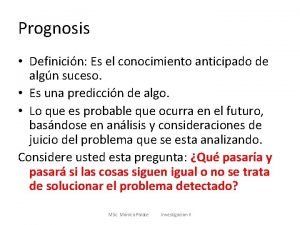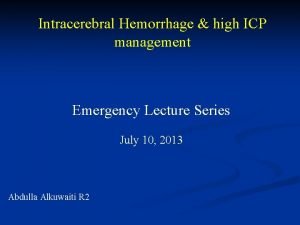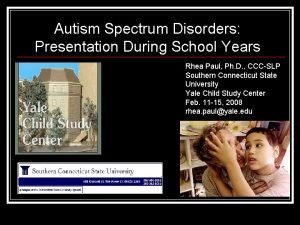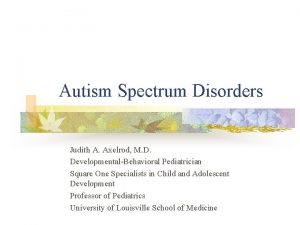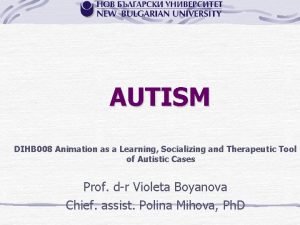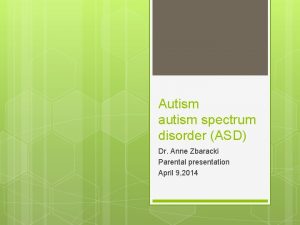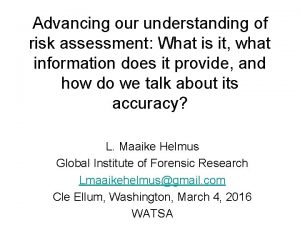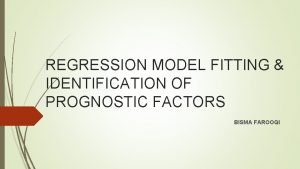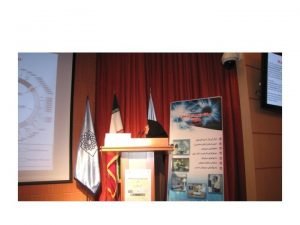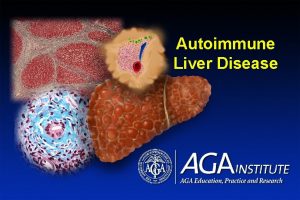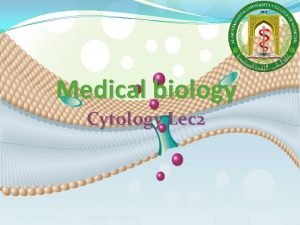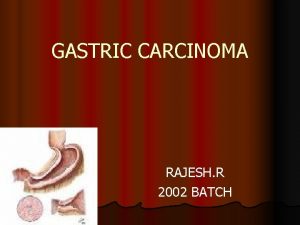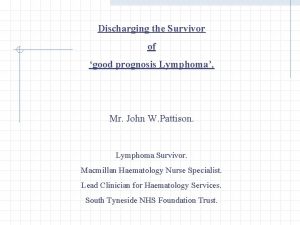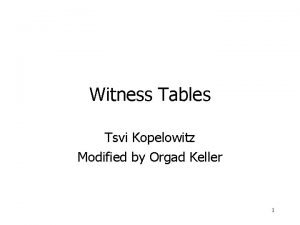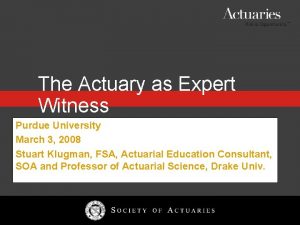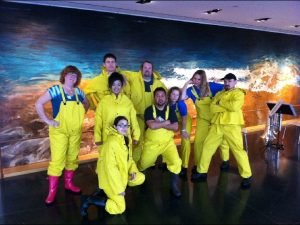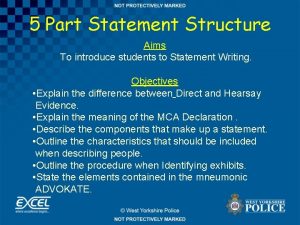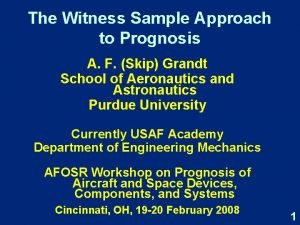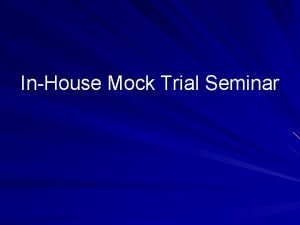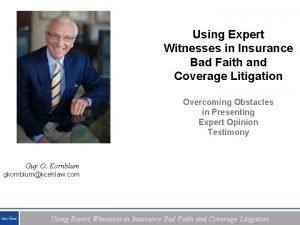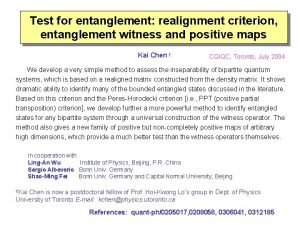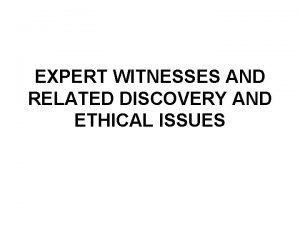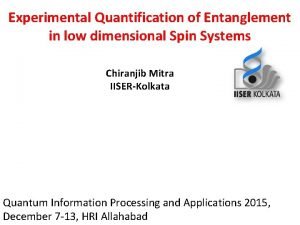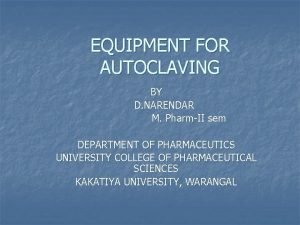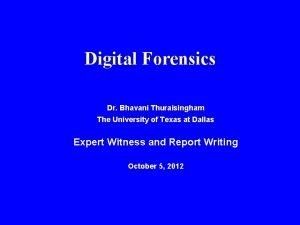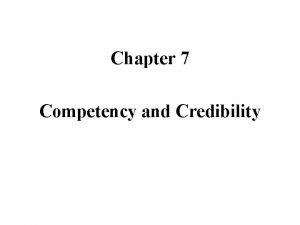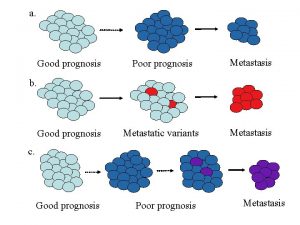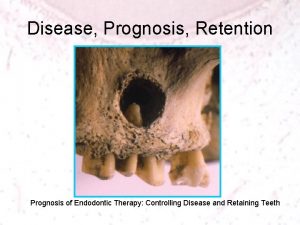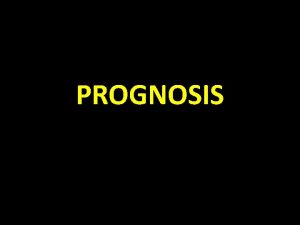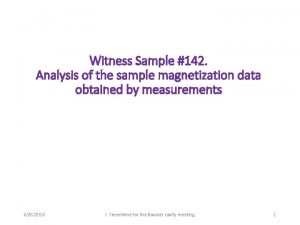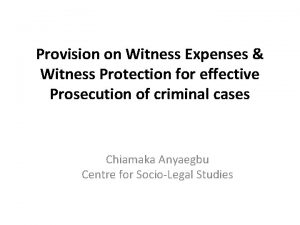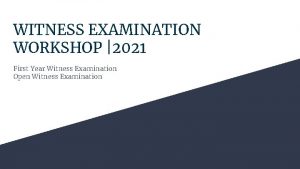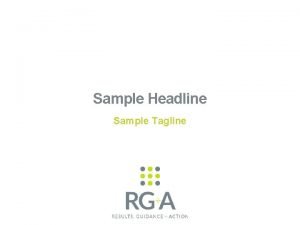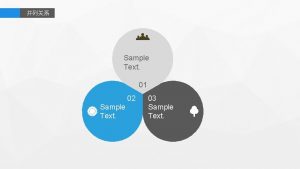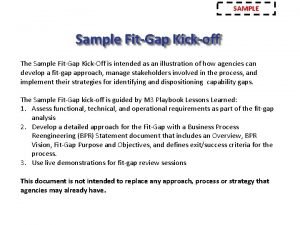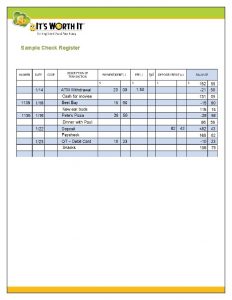The Witness Sample Approach to Prognosis A F


















































- Slides: 50

The Witness Sample Approach to Prognosis A. F. (Skip) Grandt School of Aeronautics and Astronautics Purdue University Currently USAF Academy Department of Engineering Mechanics AFOSR Workshop on Prognosis of Aircraft and Space Devices, Components, and Systems Cincinnati, OH, 19 -20 February 2008 1

Outline Objective: Review simple technique to evaluate structural usage in context of potential for fatigue/corrosion damage Describe “serial number” tracking concept Topics: Overview witness sample approach Review prior work • Uniform thickness gages • Side-groove gages • Multiple gages Summarize status/needs 2

Acknowledgements Colleagues: Joe Gallagher, Bob Crane, Noel Ashbaugh, Joe Ori, Alon Dumanis-Modan, Matt Gates Sponsors: • Air Force Materials Laboratory (~ 1976 -79) • Air Force Institute of Technology (~1977) • Air Force Flight Dynamics Laboratory/University of Dayton Research Institute (1980 -82) • Air Force Office of Scientific Research (1995 -97) 3

Objective and Approach • Mount cracked coupon (witness sample) to structure • Monitor crack extension in sample • Interpret coupon crack growth as potential for fatigue in parent structure 4

The Witness Sample Approach to Prognosis or “It Takes One to Know One!” 5

Witness Sample Overview • Crack gage is “analog computer” that measures/evaluates severity of structural loading • Growth of gage crack gives potential for structural crack growth • Crack gage is a “prognosis sensor” Structure crack Gage Crack

• Gage crack and assumed structure crack growth are related • Can “design” gage for desired response • Material • Shape • Initial crack sizes • Ease of measurement • Independent of load history under certain conditions Structure Crack Length as Transfer Function (Relate gage/structure cracks) Failure (structure) Now Gage Crack Length ag 7

Why Witness Samples? • Simpler than current tracking methods – Flight load recorders, accelerometers, . . – Expensive, extensive effort, complicated • Witness sample advantages – Simple cracked coupon – Transfer functions determine potential for structural crack growth – Can be “designed” for given response – Damage potential immediately quantified - Sensitive to same parameters as crack - Load sequence - Environment

Fatigue Crack Retardation (Load Sequence Effect) Overload Time Crack Length (a) Applied Stress Note: Peak tensile load can increase life Without Overload With Overload Elapsed Cycle (N) Fig. 7. 5 9

Fatigue Crack Retardation/Sequence (2024 -T 3 Al – Schijve) Ds = 50 Mpa; mean = 80 Mpa; R = 55/105 Mpa = 0. 52 peak = +200/-40 MPa Reference: Schijve, ASM V 19, 1996 Fig. 7. 7 10

Fatigue Nucleation Load Sequence Effects (Crews data) Constant amplitude fatigue tests with 2024 T 3 aluminum plates with open holes S 12 in S 0 – 20 ksi 2 in dia A. 230, 000 reversals = life t S 11

Example Load Sequence Effects: Crews data S S B. 0 – 20 ksi A. 230, 000 reversals S +/- 40 ksi t t 126, 000 reversals change 20 reversals +/- 40 ksi 0 – 20 ksi C. t 920, 000 reversals 19 reversals 0 – 20 ksi change Note: sequence changed life from 126, 000 to 920, 000 reversals 12

Load Sequence is Important Note: • Order in which loads are applied can have tremendous influence on fatigue life • Introduces mean stresses that can be tensile or positive • Most pronounced for spectra with many small loads and a few large loads • Sequence effect must be accounted for on prognosis data – complicates traditional load monitoring schemes 13

Crack Gage Theory • Structural and gage cracks see same number of cycles N • Assume: • da/d. N = F(K)

Theory Continued Assume power law for crack growth Assume gage/structure stress related g= f s (f depends on geometry, attachment, etc. )

Theory Concluded If structure Paris exponent, ms, equals the gage exponent, mg = m • Solve for as versus ag • Relation depends on f, ai’s, b’s, materials. . . • But independent of Stress!!

Uniform Thickness Gages (with J. A. Ori and N. E. Ashbaugh) Gages: • edge or center cracks • 2024 -T 3, 2219 -T 851, 7075 T 6 • 0. 03 inch thick • 1. 5, 2 inch length (unbond) Structure: • Cracked hole • 2219 -T 851 • 0. 24 or 0. 525 inch thick Structure crack Gage Crack 17

Edge-Crack Gage Results (Crack Length vs Cycles) • Constant amplitude stress • 10. 5 ksi • 13. 3 ksi • Crack growth depends on stress Ref: J. A. Ori & A. F. Grandt, ASTM 1979 Gage Cracks Structure Cracks 18

Edge-Crack Gage Results (Transfer Function) • Plot structure vs gage crack length • Independe nt of stress • Agrees with model 19

Center-Crack Gage Design Parameters Transfer function depends on: • Initial crack sizes • Gage/structure material • Unbond length • Gage geometry • Thickness, width • Crack configuration • Potential to “design” gage for desired response Ref: N. E. Ashbaugh & A. F. Grandt, ASTM 1979 20

Side-Grooved Crack Gage (A. Dumanis-Modan and M. Gates) Goal: • Promote plane strain in thin crack gage Similar fatigue crack retardation in thin gage and thick structure • Gage provides better estimate of structural crack growth Crack 21

Side-Grooved Gage Results ( A. Dumanis-Modan) Found that “deep double side-grooved” gages resulted in repeatable gage behavior, and fatigue retardation consistent with thick structure B/BN = 4. 0

• 7075 -T 6 alloy • 2. 0 overload ratio • 0. 63 mm thickness • Uniform • Side-groove Ref: J. P. Hess, A. Grandt, and A. Dumanis, IJFEMS, 1983 Crack length (mm) Side-Grooves Promote “Thick Section” Crack Growth Thousands of Cycles 23

Side-Grooved Gage Results (Alon Dumanis-Modan) • 17 tests with sidegrooved gages • 9 load histories • Constant amplitude (R = -0. 1, 0. 3) • 50% overload (R = - 0. 1, 0. 3) • Variable amplitude T-38 spectrum – mild – Baseline – severe) Ref: Dumanis-Modan & Grandt, EFM 1987

Side-Groove Gage Results • Scatter in data • Associated with initial crack lengths • Inherent to fatigue crack growth • Load independent model gives reasonable prediction • Curve “too steep” • “Gage crack grows too slow” 25

Side-Grooved Gage 2 (Matt Gates) Objective: Improve side-groove gage • Decrease slope of transfer function • Make gage crack grow faster than structural crack • Increase unbond length • Reduce scatter in fatigue lives • Tighten tolerances in gage dimensions • Relieve side-groove residual stresses Ref. M. D. Gates & A. F. Grandt, Jr. , SEM 1997 26

Results: Side-Groove Gage 2 • Gage response made more sensitive by increasing length (unbond) of gage • Gage growth rate 12 x structure crack growth rate • Machining of side-grooves can introduce residual stresses >> inconsistent behavior • Stress relieve of gages potential solution, but must be done carefully 27

Side-Groove Gage Transfer Function (note scale difference) 0. 2 4 constant amplitude fatigue tests 0. 0 2. 0

Structure crack as (inch) Experiment Vs. Predictive Model Gage crack ag (inch)

Multiple Gages Describe load dependent transfer function 30

Multiple Gages Concept: • Second crack gage provides additional information • Allows one to determine “effective” stress • Allows more sophisticated fatigue crack growth models • Model not limited to Paris equation • Does involve more detailed analysis 31

Double-Gage Theory Compute “effective” stress Gage 1 Gage 2 Compute structure crack Reference: A. Dumanis and A. F. Grandt, 15 th ICAF, 1989 32

Summary: Current Status • Fundamental basis for gage and structure crack relation • Experimentally verified • Uniform thickness • Side-groove gage • Double gage • “Design” gage for desired response Gage measures severity of structural loads (fatigue damage potential) 33

Summary: Research Needs • Gage attachment • Develop/evaluate attachment for long term performance • Side-groove consistency • Control machining and/or stress relief • “Tweak” design parameters • Remote measurement of gage crack length • Develop/evaluate inspection method 34

Summary • Other potential prognosis applications • Corrosion monitoring feasible • Potential for fatigue crack “nucleation” and/or total life applications • Key idea: actual damage (fatigue, corrosion, creep. . . ) in redundant component can tell much about severity of parent structural usage 35

References § § § § J. P. Gallagher, A. F. Grandt, Jr. , and R. L. Crane, “Tracking Crack Growth Damage in US Air Force Aircraft, ” Journal of Aircraft, Vol. 15, No. 7, July 1978, pp. 435 -442. N. E. Ashbaugh and A. F. Grandt, Jr. , “Evaluation of a Crack-Growth Gage for Monitoring Possible Structural Fatigue Crack Growth, ” Service Fatigue Loads Monitoring, Simulation and Analysis, ASTM Special Technical Publication 671, pp. 94 -117, 1979. Also published as AFML-TR-77 -233, February 1978. R. L. Crane, A. F. Grandt, Jr. , and J. P. Gallagher, "Assessment of Flaw Growth Potential in Structural Components, " United States Patent No. 4, 107, 980, August 22, 1978. J. A. Ori and A. F. Grandt, Jr. , “Single-Edge-Cracked Crack Growth Gage, ” Fracture Mechanics, ASTM Special Technical Publication 677, 533 -549, 1979. J. P. Hess, A. F. Grandt, Jr. , and A. Dumanis, “Effects of Side-Grooves on Fatigue Crack Retardation, ” International Journal of Fatigue of Engineering Materials and Structures, Vol. 6, No. 2, 1983, pp. 189 -199. Dumanis and A. F. Grandt, Jr. , “Development of a Side-Grooved Crack Gage for Fleet Tracking of Fatigue Damage, ” Engineering Fracture Mechanics, Vol. 26, No. 1, 1987, pp. 95 -104. A. Dumanis and A. F. Grandt, Jr. , “Development of a Double Crack Growth Gage Algorithm for Application to Fleet Tracking of Fatigue Damage, ” Proceedings International Committee on Aeronautical Fatigue 21 st Conference, 15 th Symposium, Jerusalem, Israel, June 1989. M. D. Gates and A. F. Grandt, Jr. , “Crack Gage Approach to Monitoring Fatigue Damage Potential in Aircraft, ” 1997 Society for Experimental Mechanics Spring Conference on Experimental and Applied Mechanics, June 2 -4, 1997, Bellevue, Washington (2 pages). Extended version of paper (7 double-column pages) also accepted for publication in the 1997 SEM Spring Post-conference Proceedings, 1998. 36

37

38

Crack Gage Overview • Crack gage is an “analog computer” that measures/evaluates severity of structural loading • Growth of gage crack gives potential for structural crack growth • Crack gage is a “prognosis sensor” Ps W LT a. G Crack Gage Lu a. S Ps Adhesive Structural Member

U. S. Patent 4, 107, 980 August 22, 1978 40

41

Fatigue Crack Retardation (7075 -T 6 aluminum) max / min = 18. 3/55. 2 Mpa max = 99. 3 Mpa 1/4001 cycle block No overload With overload Reference: Bucci, EFM, v 12, No. 3, 1979 Fig. 7. 6 42

Alon Dumanis-Modan Evaluation of the Crack Gage as an Advanced Individual Tracking Concept, Ph. D. Thesis, Purdue University, Dec. 1982 43

Matthew D. Gates A Crack Gage Approach to Monitoring Fatigue Damage Potential in Aircraft, M. S. Thesis, Purdue University, May 1997. 44

Joseph A. Ori Experimental Evaluation of a Single Edge Crack Growth Gage for Monitoring Aircraft Structures, M. S. Thesis, Air Force Institute of Technology, Dec 1977. 45

Thousands of delay cycles Side-Grooves Promote “Thick Section” Crack Retardation Specimen Thickness BN (mm) 46

Fatigue Crack Retardation/Sequence (2024 -T 3 Al – Schijve) Ds = 6. 6 Mpa; mean = 8. 2 Mpa; R = 4. 9/11. 5 Mpa = 0. 43 max = +19. 2 MPa , min = -2. 9 MPa Reference: Broek Fig. 10 47

Load Sequence Effects t Hi-lo strain sequence results in compressive mean stress when last large peak is tension increases life Mean stress 48

Load Sequence Effects Hi-lo strain sequence results in tensile mean stress when last large peak was compression as shown here decreases life! t Mean stress t 49

Schematic Exceedance Curve Number of exceedances/unit time (Fig. 16. 4) 0 Load Factor n • Gives the number of times given load factor exceeded in unit of time • Does not show sequence or order of applied loads 50
 Orleans hanna algebra prognosis test
Orleans hanna algebra prognosis test Conocimiento anticipado
Conocimiento anticipado Ich score prognosis
Ich score prognosis Hellp syndrome meaning
Hellp syndrome meaning Autism prognosis
Autism prognosis Splinter skills
Splinter skills Autism prognosis
Autism prognosis Kanner's syndrome
Kanner's syndrome Autism prognosis
Autism prognosis Static-99
Static-99 What is prognosis
What is prognosis Prognosis
Prognosis Child-pugh score prognosis
Child-pugh score prognosis Cholangitis prognosis
Cholangitis prognosis Good prognosis
Good prognosis Prognosis of cystic fibrosis
Prognosis of cystic fibrosis Borrmann classification of gastric cancer
Borrmann classification of gastric cancer Good prognosis
Good prognosis Witness table
Witness table Summary of witness by karen hesse
Summary of witness by karen hesse How did heck tate behave on the witness stand
How did heck tate behave on the witness stand Actuary expert witness
Actuary expert witness Steven izenour
Steven izenour Holographic will
Holographic will Unland: irreversible witness
Unland: irreversible witness Sexual assault expert witness
Sexual assault expert witness Addiction expert witnesses
Addiction expert witnesses 5 part statement example
5 part statement example The witness crack
The witness crack Witness marks metalwork
Witness marks metalwork How to make a opening statement
How to make a opening statement If the law has made you a witness
If the law has made you a witness Rsa witness
Rsa witness Antipas my faithful witness
Antipas my faithful witness Witness god's wonders
Witness god's wonders For my lord
For my lord Insurance adjustors expert witness
Insurance adjustors expert witness Entanglement witness
Entanglement witness Java lawsuit
Java lawsuit Chiranjib mitra iiser kolkata
Chiranjib mitra iiser kolkata Witness marks metalwork
Witness marks metalwork Performance qualification protocol
Performance qualification protocol Example of an expert witness digital forensics report
Example of an expert witness digital forensics report Witness competency
Witness competency The witness short story
The witness short story Expert forensic psychology witness
Expert forensic psychology witness Simulación witness
Simulación witness Witness intimidation by prosecutor
Witness intimidation by prosecutor Do not bear false witness
Do not bear false witness Letters from rifka summary by chapter
Letters from rifka summary by chapter I will embrace only the sun poem text
I will embrace only the sun poem text

